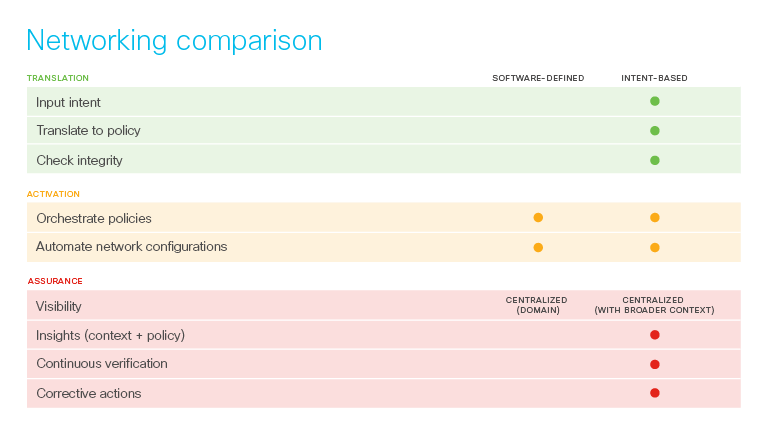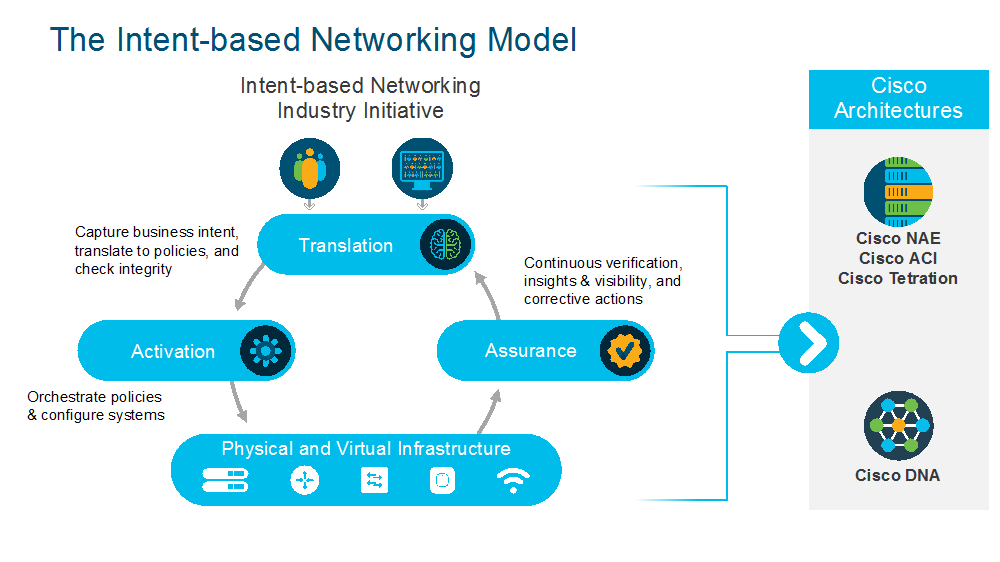Intent-based networking (IBN) is an emerging technology concept that aims to apply a deeper level of intelligence and intended state insights to networking. Ideally, these insights replace the manual processes of configuring networks and reacting to network issues. Simply put, administrators can send a request to tell the network what outcome they want (their intent) instead of needing to code and execute individual tasks manually.
What is the purpose of intent-based networking?
Intent-based networking companies range from start-ups to established networking vendors and all offer slightly different options. But the goal is the networking that uses machine learning and cognitive computing to enable more automation and less time spent on manual configuration and management. They provide software that can translate intent to network configuration. With intent-based networking, network administrators define an outcome or business objective—the intent—and the network’s software figures out how to achieve that goal, thanks to artificial intelligence and machine learning.
Intent-based networking systems not only automate time-consuming tasks and provide real-time visibility into a network’s activity to validate a given intent, they also predict potential deviations to that intent, and prescribe the action required to ensure that intent. This greater intelligence makes the network faster and more agile and reduces errors. This ability to self monitor and self correct is a core component of intent-based networking.
How does intent-based networking work?
Intent-based networking relies on artificial intelligence and machine learning to prescribe and perform routine tasks, set policies, respond to system events, and verify that goals and actions have been achieved. For example, it can make servers reachable from specific networks, if that is what’s required to achieve a given intent. The system not only configures network changes but also verifies that they are being performed, and it can make adjustments as necessary. Considered an evolution of software-defined networking (SDN), intent-based networking builds upon that technology to enable a higher level of intelligence that can define what tasks are to be automated.
What is the relationship between intent-based networking and SDN?
When considering intent-based networking versus SDN, it’s helpful to think of intent-based networking as a form of software-defined networking with additional capabilities. Software-defined networking is a way to manage a network infrastructure using software, with a single pane of glass dashboard. It enables the automation of several different time-consuming processes, including configuring and scaling a network. It also allows a network administrator to easily and quickly configure and reconfigure the network based on the need to support a specific application or task. It gives network administrators an overview of the entire network and how the different network elements are interoperating to enhance or detract from network performance.
Intent-based networking takes software-defined networking one step further. It allows a network administrator to configure a network to address and support a business case, not just an individual task. If the administrator knows what they want the network to accomplish, the intent-based network can figure out how to accomplish it while adhering to previously deployed policies. An intent-based network also continuously performs self-checks as the network changes, ensuring that the network is continuing to operate as expected. If a fix is needed, the network can suggest changes for the operator to choose from and approve.
The advantages of intent-based networking
Intent-based networking has some clear advantages over regular networking and even over software-defined networking. Most of these advantages translate to a significant time savings:
- Reduction in manual tasks: An intent-based network translates commands into actions. A network administrator does not have to configure a network to comply with a new policy or business need. The network does the thinking, verifying that a configuration will work, suggesting options to the administrator, and then making the changes to adapt to the desired configuration. The intent-based network can also provision and repair itself without human intervention.
- Faster troubleshooting and resolution: Because an intent-based network is continuously monitoring itself, performance issues are identified immediately. The intent-based network also resolves these issues, using machine learning to determine the best solution and implement it.
- Reduced risk of being out of compliance: Another advantage to a network that is constantly monitoring itself and correcting issues is that the network stays in compliance with any policies set by the network administrator.
- Better security: Part of the monitoring that the intent-based network is constantly doing is looking for threats, even in encrypted traffic. Security breaches are immediately identified and contained.
- Optimized analytics: When network administrators understand how a network is performing, they can make better decisions that result in better business outcomes. An intent-based network is constantly gathering data about itself that can be analyzed in any number of ways, providing valuable information about network performance, security threats, and more.
- Rapid implementation of business goals into network configurations: The key differentiator between an intent-based network and a software-defined network is that an intent-based network immediately translates high-level business goals into optimal network configurations to support those goals. A network administrator can quickly review and choose from vetted configuration options, which saves a tremendous amount of time spent planning, testing, and manually configuring. Meeting business goals faster translates into significant ROI.
Why is intent-based networking good news for software-defined networking?
Below by John Apostolopoulos
In a previous blog post, Cisco Engineering teams looked “under the hood” at intent-based networking.
A common question we receive is: “What is the relationship of software-defined networking (SDN) to intent-based networking?” In this blog we:
- Compare the model of SDN with intent-based networking: How are they different? What should you know?
- Share our point-of-view about why this differentiation ultimately matters to our customers.
What is SDN?
Software-defined networking (SDN) developed out of the need to automate, scale and optimize networking for applications that may be provided either via an enterprise datacenter, a Virtual Private Cloud (VPC), or as-a-service (public cloud).
We view SDN as a centralized approach to the management of network infrastructure. SDN provides a number of important benefits for network and IT operators through controller-enabled, network visibility and automation including:
- Ability to programmatically automate network configurations, increasing scalability and reliability
- Increased flexibility and agility for changing the network operation to enable an application or address a task.
- Centralized visibility of the network topology, network elements and their operation across the network infrastructure.
Beyond automation: What are the limits of SDN?
While software-defined networks (SDNs) have largely automated the process of network management, organizations now require even greater capabilities from their networks in order to manage their own digital transformation.
For example, IT teams should expect:
- Automated translation of business polices to IT (security and compliance) policies
- Automated deployment of these policies
- Assurance that if the network is not providing the requested policies, they will receive proactive notification.
These are some of the motivations for moving beyond SDN towards intent-based networking.
How intent-based networking builds on SDN
SDN is a foundational building block of intent-based networking. The good news for SDN practitioners is that intent-based networking addresses SDN’s shortfalls. Intent-based networking adds context, learning and assurance capabilities, by tightly coupling policy with intent.
Figure 1: How SDN compares to intent-based networking
“Intent” enables the expression of both business purpose and network context through abstractions, which are then translated to achieve the desired outcome for network management. Whereas, SDN is purposely focused on instantiating change in network functions.
In our previous post, we introduced the three foundational elements of intent-based networking: translation, activation and assurance (Figure 2).
Figure 2: Closed-loop feedback in an intent-based network delivered by Cisco architectures
- The translation element enables the operator to focus on “what” they want to accomplish, and not “how” they want to accomplish it. The translation element takes the desired intent and translates it to associated network policies and security policies. Before applying these new policies the system checks if these policies are consistent with the already deployed policies or if they will cause any inconsistencies.
- Once approved, the new policies are then activated (automatically deployed across the network).
- With assurance, an intent-based network performs continuous verification that the network is operating as intended. Any discrepancies are identified; root-cause analysis can recommend fixes to the network operator. The operator can then “accept” the recommended fixes to be automatically applied, before another cycle of verification.
What’s the outcome?
The expanded capabilities of intent-based networking over SDN provide operators with greater flexibility in how to act:
- Firstly, closed-loop feedback is critical to the operational success of intent-based networking.
- Secondly, assurance does not occur at discrete times in an intent-based network. Continuous verification is essential since the state of the network is constantly changing. Continuous verification assures network performance and reliability.
- Finally, if a problem occurs and a recommended fix has been identified, the operator can choose how recommended fixes are applied (depending on the user’s specified policy for that type of fix and the context of the problem), for example: routed to an administrator for “review and approval”, inserted into a ticketing system, or even automatically applied.
In summary, intent-based networking augments SDN, by delivering the network agility that organizations require to accelerate their digital transformation. By adding important capabilities, such as translation and assurance, a closed loop intent-based networking platform helps IT deliver continuous agility, reliability and security to significantly improve IT and business outcomes.
About this blog series
This “under-the-hood” blog series explores the elements of and use cases for intent-based networking. The aim is to help networking and IT professionals to gain insight into intent-based networking directly from Cisco’s engineering teams. We will share our vision of what the future holds and the opportunities and benefits that intent-based networking can provide your organization.
If you have questions or topics you’d like to see included in the series, let us know!
For a deeper dive, read our recent White Paper on Intent-Based Networking.
Ref: https://www.vmware.com/topics/glossary/content/intent-based-networking#:~:text=Intent%2Dbased%20networking%20(IBN),and%20reacting%20to%20network%20issues.


